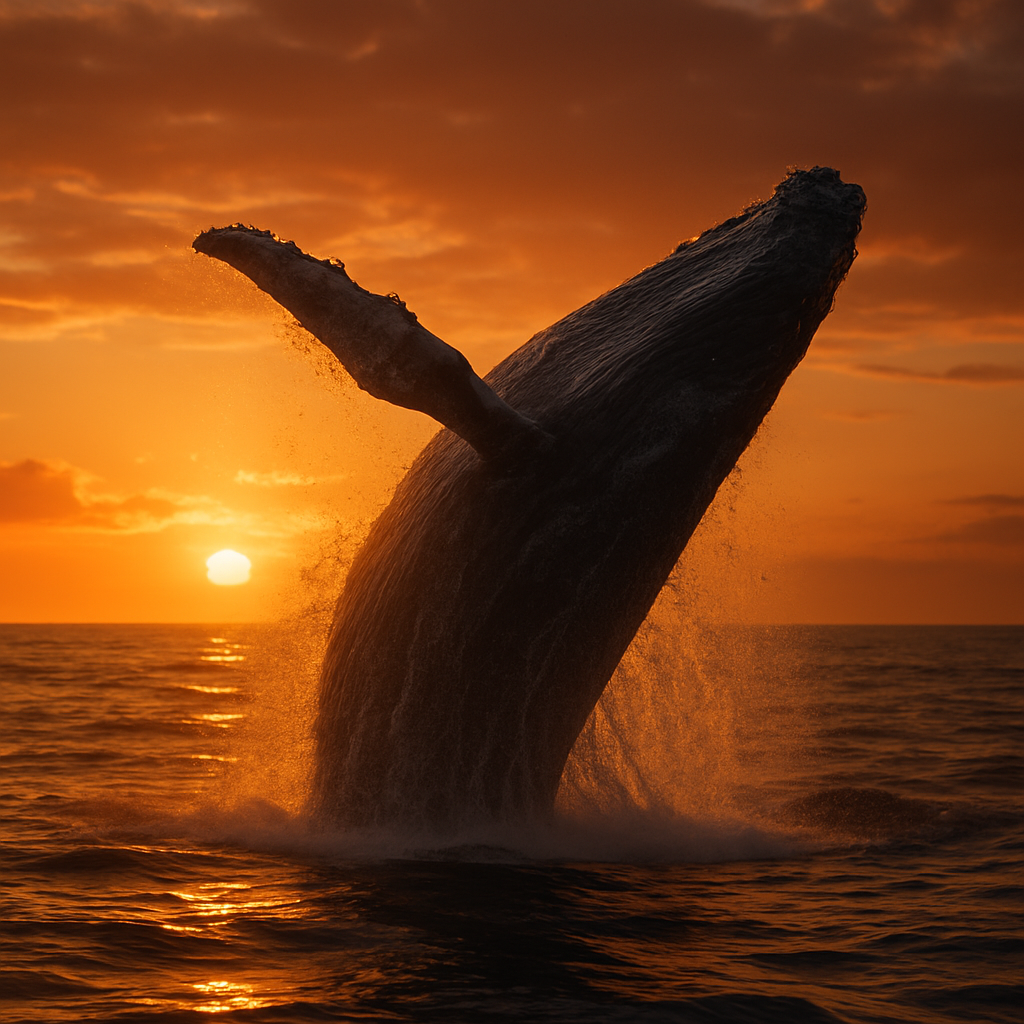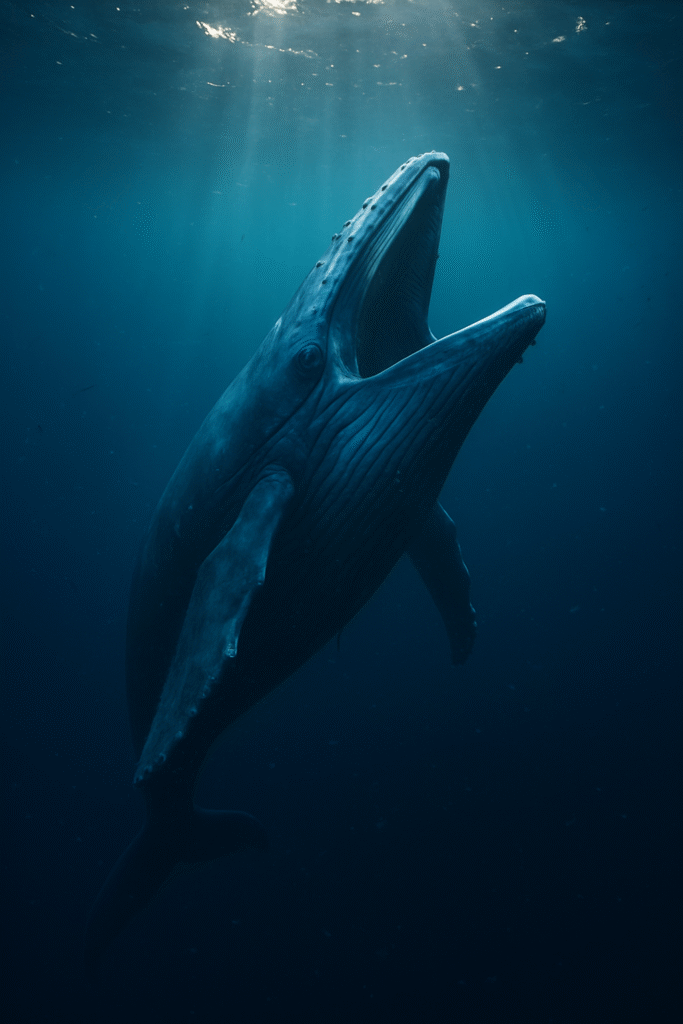1. A Breach in Time: Encounter with a Giant
The horizon glows with the amber hue of a setting sun. The ocean surface lies calm, a mirror reflecting the sky. Then, without warning, the water heaves. A colossal body rises, propelled by unimaginable strength, breaking through the stillness. For a breathless instant, the whale hangs suspended, an entire cathedral of muscle and grace framed against the fading light. Then it crashes back into the sea, sending shockwaves that ripple for miles.

To witness such an encounter is to stand before something elemental. Whales are not just animals; they are keepers of time, survivors of eras we can scarcely imagine. They are the ocean’s most enduring legends—part biology, part myth, part mystery—and they remind us of the ocean’s power to hold secrets far beyond our grasp.
2. Ancient Origins: From Land to Sea
The story of whales begins not in the water, but on land. Fifty million years ago, their ancestors were small, hoofed mammals roaming ancient riverbanks. Over millions of years, these creatures returned to the ocean, their limbs transforming into flippers, their nostrils migrating to the top of their skulls, and their bodies elongating into the streamlined forms we recognize today.
This evolutionary journey is written in their bones. The vestiges of tiny pelvic bones still linger inside their vast bodies, silent reminders that even giants carry the memory of their origins. Their return to the ocean represents one of nature’s most dramatic transformations: a complete surrender to the deep.
3. Biological Extremes: The Science of Whales
Whales stretch the boundaries of what life can achieve.
- The Blue Whale (Balaenoptera musculus): The largest animal ever to exist, longer than two buses, weighing as much as 33 elephants. Its heart alone is the size of a small car.
- The Sperm Whale (Physeter macrocephalus): A deep-sea diver, capable of descending over 2,000 meters in pursuit of squid, holding its breath for more than 90 minutes.
- The Humpback Whale (Megaptera novaeangliae): An acrobat and composer, known for spectacular breaches and haunting, evolving songs that travel for hundreds of kilometers.
- The Narwhal (Monodon monoceros): The “unicorn of the sea,” whose spiral tusk inspired centuries of myth and legend.
Their physiology defies human imagination: lungs that collapse under pressure to avoid nitrogen sickness, muscles rich in oxygen-storing myoglobin, and communication systems capable of reaching across oceans.

Whales are not only marvels of size but also architects of ecosystems. Their fecal plumes fertilize plankton blooms, which in turn feed the marine food web and absorb massive amounts of carbon. Protecting whales is not only about saving a species—it is about safeguarding the planet’s climate balance.
4. The Whale in Human Mythology
Whales have loomed in human stories for millennia, often appearing at the edge of the known world, where reality and imagination collide.
- The Leviathan: In the Hebrew Bible, Leviathan was a sea monster of chaos, embodying both fear and divine power.
- The Hafgufa: Norse sailors told tales of a whale so vast it could be mistaken for an island, luring ships to rest before drowning them.
- Polynesian Traditions: To many Pacific cultures, whales are ancestors, protectors, and guides. Māori carvings depict them as kin, linking humanity to the ocean’s sacred rhythms.
- Japanese Lore: The Isana—giant whales—were believed to control the sea’s bounty and storms.
- Greek Mythology: Poseidon sent sea monsters, often whale-like in form, as instruments of punishment. The tale of Perseus and Andromeda is one such myth.
These stories reveal that whales were never merely animals. They were omens, gods, monsters, and symbols of the vast unknown. Their enormity and rarity ensured they always belonged as much to the realm of myth as to the ocean itself.
5. Whale Song: The Music of the Deep
In the 1960s, hydrophones captured for the first time the haunting songs of humpback whales. Long, evolving patterns of sound—melancholic, resonant, and strangely human—revealed a dimension of animal life few had imagined. These recordings changed the world.
Whale song entered popular culture, featured on records, in concerts, and even broadcast into space aboard the Voyager Golden Record as a message of Earth’s life to the cosmos. Conservation movements embraced the whale song as their anthem, sparking the “Save the Whales” campaign that redefined environmental activism.
But beyond human emotion, these songs serve crucial roles: communication across vast distances, possibly even courtship and social learning. Some populations change their songs year after year, passing along cultural “dialects” that ripple across oceans.
It is not just noise—it is culture carried in sound waves through water, an underwater symphony older than civilization itself.
6. The Age of Whaling: From Reverence to Exploitation
Despite reverence, humanity’s history with whales is also one of brutality.
- Early Whaling: Indigenous peoples hunted whales for subsistence, honoring them in ritual and art.
- Industrial Slaughter: By the 18th and 19th centuries, whale oil fueled lamps, baleen was used in corsets, and ambergris became a coveted perfume ingredient. The oceans became battlefields.
- The 20th Century: Industrial fleets equipped with explosive harpoons turned the ocean red. By mid-century, species like the blue whale were reduced by over 90%.
The tide turned with global outrage in the 1970s, when the plight of whales became symbolic of humanity’s destructive power. The International Whaling Commission’s 1986 ban on commercial whaling marked a pivotal moment in conservation history.
Yet, even today, some nations continue whaling, and whales face new dangers: ship strikes, entanglement in fishing gear, pollution, and the warming of seas that alters their prey.
7. Whales as Cultural Symbols
Whales occupy a paradox in human culture: they are both terrifying and sacred.
- Wisdom: In many Indigenous traditions, whales symbolize longevity, teaching, and guardianship.
- Mystery: To sailors, a whale sighting could mean fortune or disaster, depending on the mood of the sea.
- Death and Resurrection: The biblical Jonah, swallowed by a “great fish,” became an allegory of death, rebirth, and divine purpose.
- Literary Obsession: In Herman Melville’s Moby-Dick, the white whale became a symbol of the unknowable and the destructive power of obsession.
Every culture that has encountered whales has projected its fears, hopes, and philosophies onto them. To see a whale was to confront the limits of human knowledge.

8. Science Meets Philosophy: Lessons from Giants
Modern research continues to reveal startling truths:
- Intelligence: Sperm whales live in clans with distinct vocal “codas.” Humpbacks show evidence of learning and cultural transmission.
- Emotion: Observations of mothers grieving dead calves suggest emotional depth once thought uniquely human.
- Ecology: Whales are engineers of the ocean. Their migrations redistribute nutrients, supporting life from plankton to fish to seabirds.
Philosophically, whales remind us of humility. Despite advanced technology, much of their world remains hidden. They embody the unknown—and humanity’s yearning to touch it.
9. Whales and the Climate Future
In recent years, scientists have discovered that protecting whales is a powerful climate solution. Each whale’s life cycle contributes to ocean health:
- A single great whale may capture 33 tons of CO₂ in its body over its lifetime.
- When whales die and sink, they carry this carbon to the deep ocean for centuries.
- Their feeding cycles stimulate phytoplankton growth, which produces half the oxygen we breathe and captures enormous amounts of carbon.
To save whales is to save ourselves. In a warming world, they are not relics of myth—they are allies in survival.
10. Closing Scene: The Vanishing Tail
The ocean darkens as twilight falls. Somewhere in the vast Pacific, a whale begins to dive. Slowly, its back arches, and at last, the fluke rises—massive, elegant, water streaming in silver rivulets. It pauses for a single instant before slipping into the abyss. The sea closes, the surface stills, and the giant is gone.
But below, in the endless dark, its song continues. It resonates through the ocean’s corridors, a hymn of endurance, a voice of the deep, reminding us that wonder is never extinct, only waiting.


Reply